初中英语零基础学语法--英语句子结构 课件(共43张PPT)
文档属性
| 名称 | 初中英语零基础学语法--英语句子结构 课件(共43张PPT) | 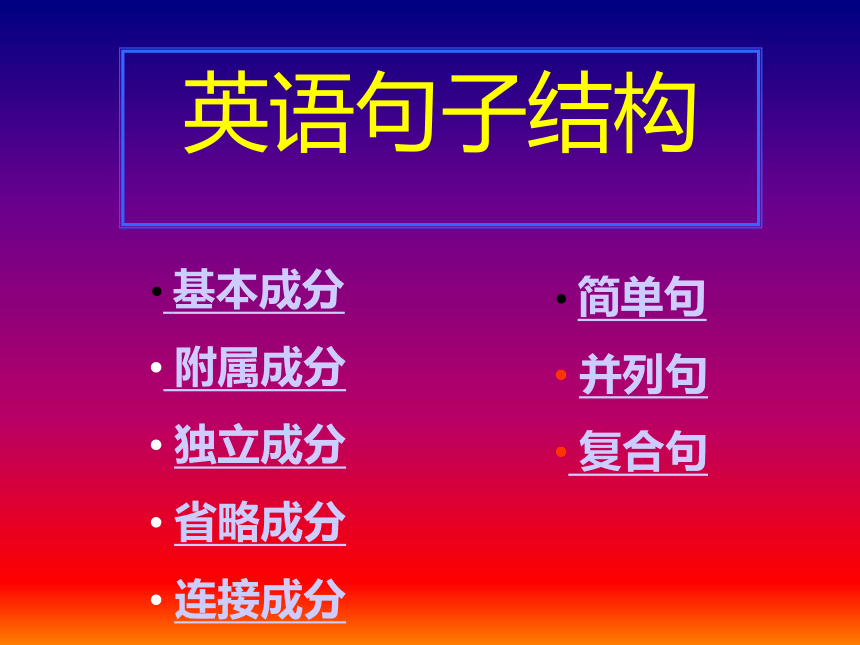 | |
| 格式 | ppt | ||
| 文件大小 | 771.0KB | ||
| 资源类型 | 教案 | ||
| 版本资源 | 通用版 | ||
| 科目 | 英语 | ||
| 更新时间 | 2024-08-04 18:40:48 | ||
图片预览

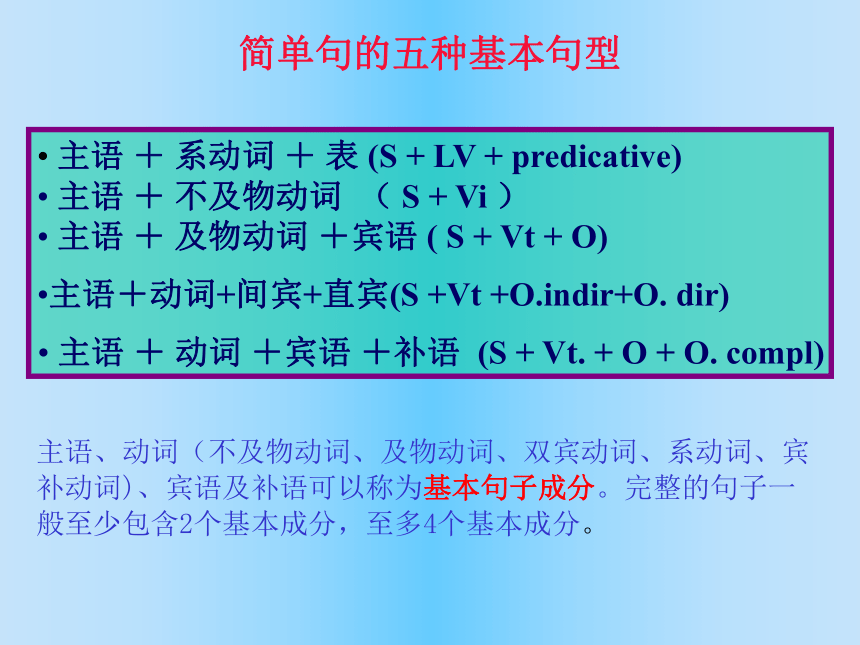

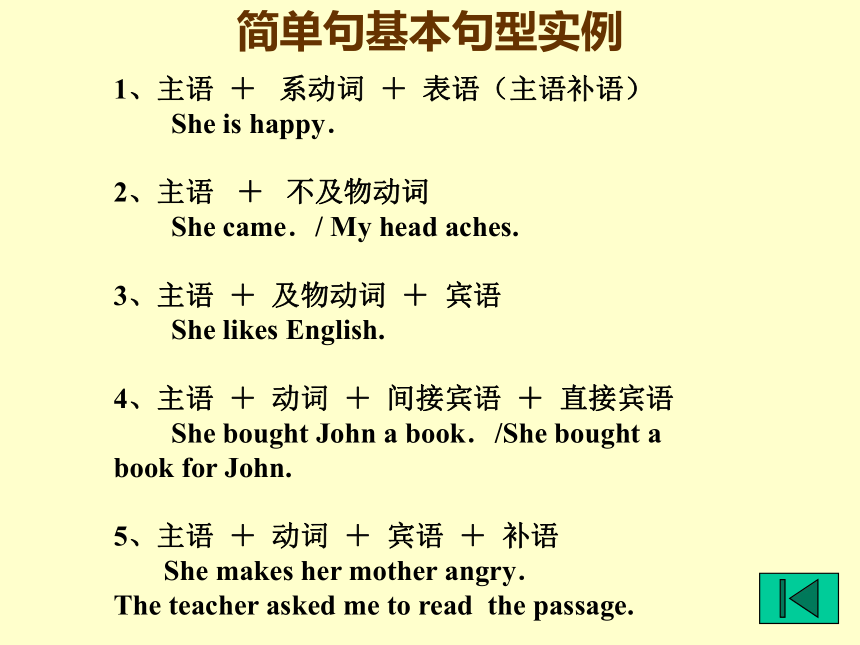
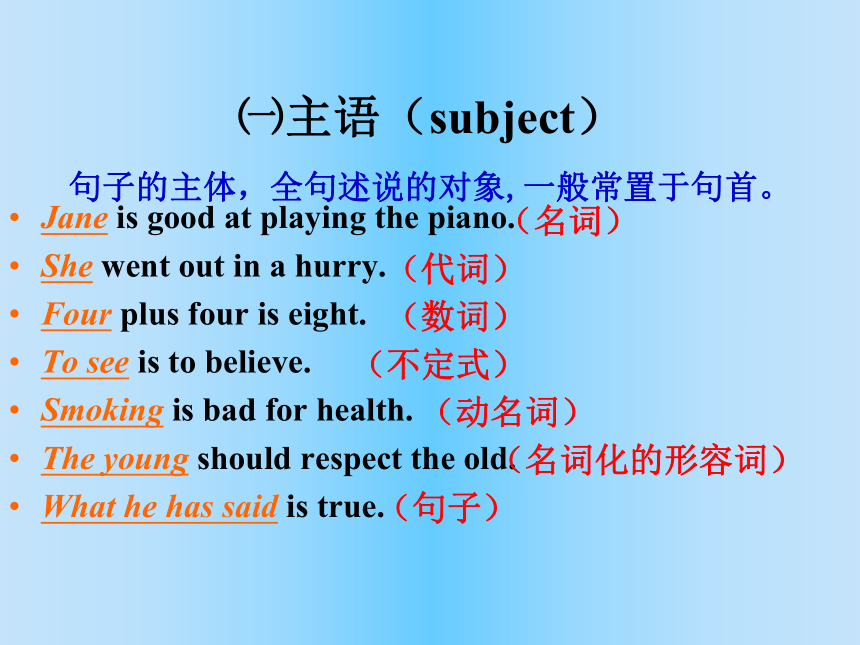




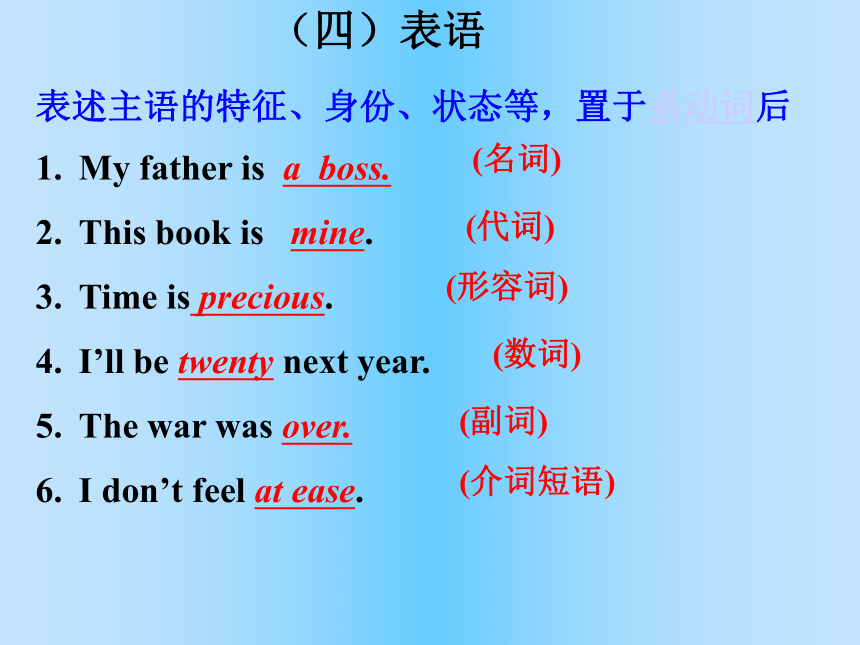

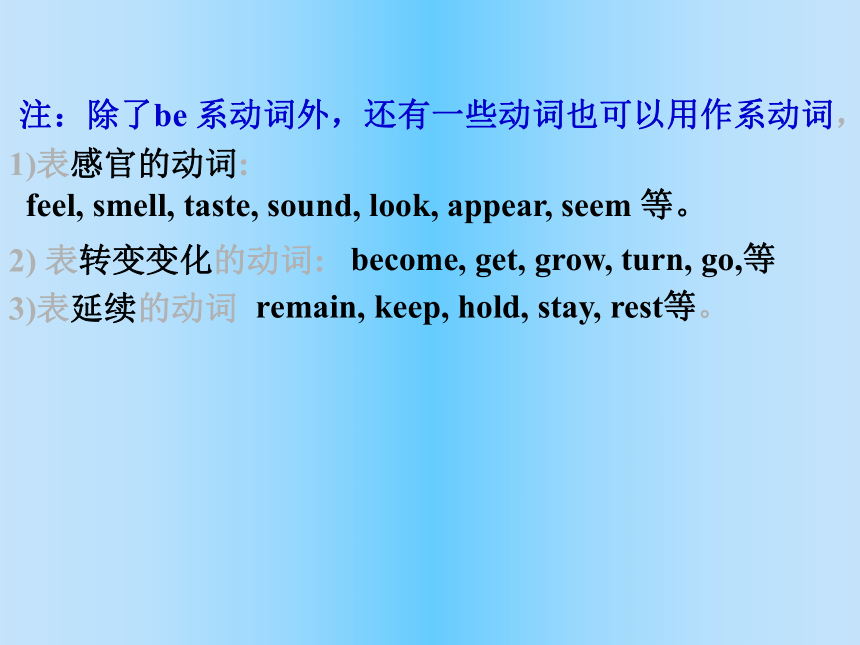
文档简介
(共43张PPT)
英语句子结构
基本成分
附属成分
独立成分
省略成分
连接成分
简单句
并列句
复合句
主语 + 系动词 + 表 (S + LV + predicative)
主语 + 不及物动词 ( S + Vi )
主语 + 及物动词 +宾语 ( S + Vt + O)
主语+动词+间宾+直宾(S +Vt +O.indir+O. dir)
主语 + 动词 +宾语 +补语 (S + Vt. + O + O. compl)
简单句的五种基本句型
主语、动词(不及物动词、及物动词、双宾动词、系动词、宾补动词)、宾语及补语可以称为基本句子成分。完整的句子一般至少包含2个基本成分,至多4个基本成分。
主语
谓语
宾语
宾语
宾补
表语
宾语(间)
宾语(直)
Vt(及物动词)
系动词
Vi(不及物动词)
be / feel / seem / look
appear / stand / lie
become /get / grow / turn
go / come / remain/ keep
taste / smell etc.
1、主语 + 系动词 + 表语(主语补语)
She is happy.
2、主语 + 不及物动词
She came./ My head aches.
3、主语 + 及物动词 + 宾语
She likes English.
4、主语 + 动词 + 间接宾语 + 直接宾语
She bought John a book./She bought a book for John.
5、主语 + 动词 + 宾语 + 补语
She makes her mother angry.
The teacher asked me to read the passage.
简单句基本句型实例
㈠主语(subject)
句子的主体,全句述说的对象,一般常置于句首。
Jane is good at playing the piano.
She went out in a hurry.
Four plus four is eight.
To see is to believe.
Smoking is bad for health.
The young should respect the old.
What he has said is true.
(名词)
(代词)
(数词)
(不定式)
(动名词)
(名词化的形容词)
(句子)
找出句中主语
The sun rises in the east.
Twenty years is a short time in history.
The poor are now living in the shelter.
Seeing is believing.
To see is to believe.
He likes dancing.
What he needs is a book.
It is very clear that the elephant is round and tall like a tree.
(名词)
(代词)
(数词)
(动名词)
(不定式)
(句子)
(名词化的形容词)
(It形式主语,主语从句是真正主语)
㈡谓语
说明主语的动作、状态,常置于主语后
简单谓语:由动词或动词词组组成
I saw the flag on the top of the hill
He looked after two orphans.
复合谓语 :由情态动词或助动词+动词构成;
He can speak English well.
She doesn’t seem to like dancing
My father is watching TV
Show your passport, please.
She didn't say anything.
How many do you want - I want two.
They sent the injured to hospital.
They decided to leave now.
I enjoy working with you.
Did you write down what he said
(名词 )
( 代词)
(数词)
(名词化的形容词)
(三)宾语 动作的对象或承受者,常置于及物动词或介词后
(不定式)
(动名词)
(句子)
宾语分为直接宾语和间接宾语.直接宾语指物或事,间接宾语指人或动物.
He gave me some books.
↓
间接
宾语
↓
直接
宾语
●please pass me the book.
●He bought his girlfriend some flowers.
(四)表语
表述主语的特征、身份、状态等,置于系动词后
My father is a boss.
This book is mine.
Time is precious.
I’ll be twenty next year.
The war was over.
I don’t feel at ease.
(形容词)
(代词)
(名词)
(数词)
(副词)
(介词短语)
7. They seem to know the truth.
8. His main hobby is smoking .
9. This story is very interesting .
10. Never touch an electric wire when it is broken .
11. Is that why you were angry
(不定式)
(现在分词/形容词)
(动名词/名词)
(过去分词/形容词)
(从句)
注:除了be 系动词外,还有一些动词也可以用作系动词,
1)表感官的动词:
2) 表转变变化的动词:
3)表延续的动词
feel, smell, taste, sound, look, appear, seem 等。
become, get, grow, turn, go,等
remain, keep, hold, stay, rest等。
There be 结构
1、定义:There be句型表示某处存在某物或某人。
2、结构:(1) There is +单数可数名词/不可数名词+ 地点状语.
(2) There are +复数名词+地点状语.
注意事项: there是引导词,在句中不充当任何成分,翻译时也不必译出。句子的主语是某人或某物,谓语动词be要与主语(某人或某物)的数保持一致。当主语是两个或两个以上的名词时,谓语动词要与跟它最近的那个名词一致。如:
① There is a bird in the tree. 树上有一只鸟。
② There is a teacher and many students in our classroom. 我们教室里有一位老师和许多学生。
③ There are two boys and a girl under the tree. 树下有两个男孩,一个女孩。
1.不定式(to do)
Father will not allow us to play on the street. 父亲不让我们在街上玩耍。
2.名词
At the meeting we elected him monitor.
I think your brother a clever boy.
3.形容词
I found the classroom empty.
4.副词
Please call the students back at once.
5.现在分词
We hear him singing in the hall.
I found him lying in bed, sleeping.
6.过去分词
He saw his face reflected in the water.
认识补语
附属成分
基本成分的修饰语。可以是:
定语:即用来修饰名词的单词、短语或从句
状语:即用来修饰名词或代词以外的词的单词、短语或从句。
定 语
Poor John tottered toward a hospital nearby.
She likes oranges imported from the USA.
John gave Mary many books,which are full of illustrations.
Have you seen the book on the desk
The boy playing over there is my brother.
People there like sports.
John often came to chat with me.
John likes oranges very much.
Whenever he gets drunk,John makes Mary very angry.
Hearing the news, he jumped with joy.
As he was ill, he didn’t come to class yesterday.
She is sitting at the desk, doing her homework.
My father worked in this school ten years ago.
You’d better stay here.
状 语
Examples:
Oh!What is that!(惊叹词)
He has,alas,failed again. (哎呀,唉)
Come here,John.(呼语)
Roll on,Ocean,roll on.(流动啊,海洋,流动 )
句中可以去掉的成分,去掉后不影响句子的完整性。这种成分和句子的其他词没有语法的关系。
独立成分
(You) Come here.
(I wish you)Good luck!
Some gave him praises,but others(gave him)rotten eggs.
He runs as fast as, if ( he does ) not ( run ) faster, than you.
( I ) Hope you like it.
John should clean the room today and Peter ( should clean it ) tomorrow.
句中被省略的成分,虽然未说出来,却在句中表示一定的意思:
省略成分
连接成分实际上是一个连词,用来连接两个或几个平行的词、短语和分句。这种连词叫做并列连词。
He tried hard but he was unsuccessful.
I used to live in Paris and London.
另一类连接成分是用来连接两个句子、且一个句子从属于另一个句子(即从句)的连词。这类连词叫从属连词。从属连词主要用于引导各种从句。
He said that he did not want to go .
You may come if you want to.
一个完整的句子(主句或从句)必须包含2个到4个基本成分,此外,如果意思上有需要,还可包含一个或更多其他的句子成分。
连接成分
There be 结构
1、定义:There be句型表示某处存在某物或某人。
2、结构:(1) There is +单数可数名词/不可数名词+ 地点状语.
(2) There are +复数名词+地点状语.
注意事项: there是引导词,在句中不充当任何成分,翻译时也不必译出。句子的主语是某人或某物,谓语动词be要与主语(某人或某物)的数保持一致。当主语是两个或两个以上的名词时,谓语动词要与跟它最近的那个名词一致。如:
① There is a bird in the tree. 树上有一只鸟。
② There is a teacher and many students in our classroom. 我们教室里有一位老师和许多学生。
③ There are two boys and a girl under the tree. 树下有两个男孩,一个女孩。
总结:
句子必须主谓俱备
一般情况下主在谓前
表语定在系动词后
宾语有双宾结构和复合结构(宾补),宾补肯定在宾语后
定语不一定在它修饰的词前面
状语最灵活,功能最为强大
除了谓语、宾补之外,其它都可以由从句充当
简单句只有一个限定动词(即只有一个主谓结构),它是最小的句子单位。主要起下列四种作用中的一种。
作一种陈述
提出一个问题
发出一种命令或请求
表示一种感叹
Examples:
The boy hit the dog. / The dog bit the boy.
The girl read the books. / The books pleased the girl.
Stephen apologized at once.
Does the shop close at 7 tonight
Shut the door.
What a slow train this is!
简单句的基本词序
主语 动词部分 宾语 状语
(谓语) 方式 地点 时间
I bought a hat yesterday.
The children ran home.
The taxi driver shouted at me angrily.
We ate our meal in silence.
The car stopped suddenly.
A young girl walked confidently in the room.
They drove him away in a police car.
简单句的扩展成份
简单句的主语、宾语可以加上一个短语(如定语)来扩展,及物动词或不及物动词也可以与其它短语(如状语)连用进行扩展。
I bought a rain coat with a warm lining.
The dog jumped through the window.
He is saving up to buy a mobile phone.
A bright little boy with rosy cheeks put three bottles of milk quietly on my doorstep before seven o’clock.
He worked like a madman in the garden on Saturday.
The young girl with long black hair seems to be very happy.
两个简单句的主语可以连词and、but、both..and、either…or、neither…nor、not only…but also等连词连接组成一个简单句,但应注意主语和谓语动词的一致性。
The boss is flying to Paris. His secretary is flying to Paris.
The boss and his secretary are flying to Paris.
Both the boss and his secretary are flying to Paris.
The boss is flying to Rome. His secretary is not flying to Rome.
The boss but not his secretary is flying to Rome.
The boss may be flying to Berlin. His secretary may be flying to Berlin.
Either the boss or his secretary is flying to Berlin.
The boss is not flying to York. His secretary isn’t flying to York.
Neither the boss nor his secretary is flying to York.
主语、谓语、宾语的合并
两个简单句的宾语可由and、both…and等连词连接组成一个简单句。
I met Jane. I met her husband.
I met Jane and her husband.
I met both Jane and her husband.
It was cold. It was wet.
It was cold and wet.
I didn’t meet Jane. I didn’t meet her husband.
I didn’t meet either Jane or her husband.
I met neither Jane nor her husband.
两个或两个以上限定动词也可合并为一个简单句。
We sang all night. We danced all night.
We sang and danced all night.
主语、谓语、宾语的合并
并列句
需把几个意思连接在一起时,可用分号或把两个或几个简单句用并列连词连接起来,这种结构即构成一个并列句。
用分号:
We fished all day; we didn’t catch a thing.
用分号,后跟一个连接副词:
We fished all day; however, we didn’t catch a thing.
用并列连词(如and、but、so、yet等)
We fished all day, but (we) didn’t catch a thing.
并列句
常用并列连词 coordinating conjunctions
平行并列连词:
转折并列连词:
因果并列连词:
选择并列连词:
and, both…and, not only…but also, neither…nor, and then
but, however, while, yet
for, so
or, either…or
并列句
并列句的词序:并列句基本上保留了简单句的词序。
主语 谓语 宾语 连词 主语 动词 表语
Jimmy fell off his bike but (he) wasn’t hurt.
五种简单句型可用并列连词连接起来组成并列句。
主 谓 状(方式) 连 主 谓 表
Frank worked hard and (he ) became an architect.
主 谓 宾 连 主 谓 地点
I ’ve got a cold, so I ’m going to bed.
主 谓 宾 宾补 连 主 谓 宾
They made him chairman, but (they) didn’t increase his salary.
Exercise:
请用合适的并列连词把每组句子合并为一个并列句。
He was tired, so he went to bed.
1. He was tired. He went to bed.
2. The child hid behind his mother's skirt. He was afraid of the dog.
3. He made a promise. He didn’t keep it.
He made a promise, but He didn’t keep it.
The child hid behind his mother's skirt, for he was afraid of the dog.
由一个主句和一个或者一个以上从句所
构成的句子。在英语书面语中应用广泛。
主句是一个完整的句子,它可以独立存在。
从句是一个不完整的句子,它必须和一个
主句连用,不能独立存在。
复合句可以通过把两个以上简单句连接
在一起构成,但复合句的各组成部份并非
同等重要,其中一个句子由从属连词引
导(从句),用以修饰另一句子(主句)。
复合句 = 主句 + 从句
复合句
复合句是在简单句的基础上,通过从属连词将两个或两个以上简单句连接在一起而构成。从属连词所引导的从句起形容词、名词、副词的作用。复合句主要包含以下类型从句:
1. 主语从句 2. 宾语从句
3. 表语从句 4. 定语从句
5. 状语从句 6. 同位语从句
英文写作中最常使用的从句
宾语从句
状语从句
定语从句
复合句与简单句:复合句 = 简单句 + 从属连词 +简单句
He told me
the news.
that the match had
been cancelled.
宾语
how much he was prepared
to pay for my car.
that I could have the
money without delay.
how much he was prepared to
pay for my car and that I could
have the money without delay.
when he was
leaving for Paris.
that his father
was working in
that school.
宾语从句
复合句与简单句:复合句 = 简单句 + 从属连词 +简单句
I don’t know
him.
He has finished his work
that he has finished his work.
whether he has finished his work.
宾语从句
He is leaving for Washington.
that he is leaving for Washington.
when he is leaving for Washington.
why he is leaving for Washington.
how he is leaving for Washington.
whether he is leaving for Washington.
复合句与简单句:复合句 = 简单句 + 从属连词 +简单句
the people
surprised
That
What he said
what he did
主语
That he didn’t
know the answer
in the room.
定语
who were sitting in the room.
who were present.
whose sons were at war.
who had signed the contract.
复合句与简单句:复合句 = 简单句 + 从属连词 +简单句
That
is
the fact.
表 语
what he needs.
what he gave me.
why he was late.
because he was ill.
what has happened.
复合句与简单句:复合句 = 简单句 + 从属连词 +简单句
He worked
in that factory
three years ago.
地点状语
时间状语
where his
father worked
in that factory
where I lived
when he
lived there
His father worked there.
I lived there.
He lived there
three years ago.
复合句与简单句:复合句 = 简单句 + 从属连词 +简单句
Put the book
on the desk.
where you took it.
where it was.
地点状语
where you found it.
You can’t camp
here.
where there are
a lot of trees.
wherever you like.
指出下列各从句的类型
I believe that everything is going on well.
She was reading a novel when I came in.
She is the girl who sings best in my class.
宾语从句
状语从句
定语从句
Practice
用所给连词连接句子。
He has found out. She was late. (why)
He has found out why she was late.
I still remember the day. I first went to York on that day. (when)
I still remember the day when I first
went to York.
将各组句子连接为一个含有状语从句的复合句。
Practice
He didn’t come yesterday. He was ill. (原因)
He didn’t come yesterday because he was ill.
I’ll give the letter to him. I see him. (时间)
It is such a big box. Nobody can move it. (结果)
We’ll go to the great wall. It’s fine tomorrow. (条件)
We should not go there all the time. The place is quite pleasant.(让步)
It is such a big box that nobody can move it.
We’ll go to the great wall if it’s fine tomorrow.
Although the place is quite pleasant, we should not go there all the time.
I’ll give the letter to him when I see him.
I’ll give the letter to him as soon as I see him.
I’ll give the letter to him the moment I see him.
T H E E N D
英语句子结构
基本成分
附属成分
独立成分
省略成分
连接成分
简单句
并列句
复合句
主语 + 系动词 + 表 (S + LV + predicative)
主语 + 不及物动词 ( S + Vi )
主语 + 及物动词 +宾语 ( S + Vt + O)
主语+动词+间宾+直宾(S +Vt +O.indir+O. dir)
主语 + 动词 +宾语 +补语 (S + Vt. + O + O. compl)
简单句的五种基本句型
主语、动词(不及物动词、及物动词、双宾动词、系动词、宾补动词)、宾语及补语可以称为基本句子成分。完整的句子一般至少包含2个基本成分,至多4个基本成分。
主语
谓语
宾语
宾语
宾补
表语
宾语(间)
宾语(直)
Vt(及物动词)
系动词
Vi(不及物动词)
be / feel / seem / look
appear / stand / lie
become /get / grow / turn
go / come / remain/ keep
taste / smell etc.
1、主语 + 系动词 + 表语(主语补语)
She is happy.
2、主语 + 不及物动词
She came./ My head aches.
3、主语 + 及物动词 + 宾语
She likes English.
4、主语 + 动词 + 间接宾语 + 直接宾语
She bought John a book./She bought a book for John.
5、主语 + 动词 + 宾语 + 补语
She makes her mother angry.
The teacher asked me to read the passage.
简单句基本句型实例
㈠主语(subject)
句子的主体,全句述说的对象,一般常置于句首。
Jane is good at playing the piano.
She went out in a hurry.
Four plus four is eight.
To see is to believe.
Smoking is bad for health.
The young should respect the old.
What he has said is true.
(名词)
(代词)
(数词)
(不定式)
(动名词)
(名词化的形容词)
(句子)
找出句中主语
The sun rises in the east.
Twenty years is a short time in history.
The poor are now living in the shelter.
Seeing is believing.
To see is to believe.
He likes dancing.
What he needs is a book.
It is very clear that the elephant is round and tall like a tree.
(名词)
(代词)
(数词)
(动名词)
(不定式)
(句子)
(名词化的形容词)
(It形式主语,主语从句是真正主语)
㈡谓语
说明主语的动作、状态,常置于主语后
简单谓语:由动词或动词词组组成
I saw the flag on the top of the hill
He looked after two orphans.
复合谓语 :由情态动词或助动词+动词构成;
He can speak English well.
She doesn’t seem to like dancing
My father is watching TV
Show your passport, please.
She didn't say anything.
How many do you want - I want two.
They sent the injured to hospital.
They decided to leave now.
I enjoy working with you.
Did you write down what he said
(名词 )
( 代词)
(数词)
(名词化的形容词)
(三)宾语 动作的对象或承受者,常置于及物动词或介词后
(不定式)
(动名词)
(句子)
宾语分为直接宾语和间接宾语.直接宾语指物或事,间接宾语指人或动物.
He gave me some books.
↓
间接
宾语
↓
直接
宾语
●please pass me the book.
●He bought his girlfriend some flowers.
(四)表语
表述主语的特征、身份、状态等,置于系动词后
My father is a boss.
This book is mine.
Time is precious.
I’ll be twenty next year.
The war was over.
I don’t feel at ease.
(形容词)
(代词)
(名词)
(数词)
(副词)
(介词短语)
7. They seem to know the truth.
8. His main hobby is smoking .
9. This story is very interesting .
10. Never touch an electric wire when it is broken .
11. Is that why you were angry
(不定式)
(现在分词/形容词)
(动名词/名词)
(过去分词/形容词)
(从句)
注:除了be 系动词外,还有一些动词也可以用作系动词,
1)表感官的动词:
2) 表转变变化的动词:
3)表延续的动词
feel, smell, taste, sound, look, appear, seem 等。
become, get, grow, turn, go,等
remain, keep, hold, stay, rest等。
There be 结构
1、定义:There be句型表示某处存在某物或某人。
2、结构:(1) There is +单数可数名词/不可数名词+ 地点状语.
(2) There are +复数名词+地点状语.
注意事项: there是引导词,在句中不充当任何成分,翻译时也不必译出。句子的主语是某人或某物,谓语动词be要与主语(某人或某物)的数保持一致。当主语是两个或两个以上的名词时,谓语动词要与跟它最近的那个名词一致。如:
① There is a bird in the tree. 树上有一只鸟。
② There is a teacher and many students in our classroom. 我们教室里有一位老师和许多学生。
③ There are two boys and a girl under the tree. 树下有两个男孩,一个女孩。
1.不定式(to do)
Father will not allow us to play on the street. 父亲不让我们在街上玩耍。
2.名词
At the meeting we elected him monitor.
I think your brother a clever boy.
3.形容词
I found the classroom empty.
4.副词
Please call the students back at once.
5.现在分词
We hear him singing in the hall.
I found him lying in bed, sleeping.
6.过去分词
He saw his face reflected in the water.
认识补语
附属成分
基本成分的修饰语。可以是:
定语:即用来修饰名词的单词、短语或从句
状语:即用来修饰名词或代词以外的词的单词、短语或从句。
定 语
Poor John tottered toward a hospital nearby.
She likes oranges imported from the USA.
John gave Mary many books,which are full of illustrations.
Have you seen the book on the desk
The boy playing over there is my brother.
People there like sports.
John often came to chat with me.
John likes oranges very much.
Whenever he gets drunk,John makes Mary very angry.
Hearing the news, he jumped with joy.
As he was ill, he didn’t come to class yesterday.
She is sitting at the desk, doing her homework.
My father worked in this school ten years ago.
You’d better stay here.
状 语
Examples:
Oh!What is that!(惊叹词)
He has,alas,failed again. (哎呀,唉)
Come here,John.(呼语)
Roll on,Ocean,roll on.(流动啊,海洋,流动 )
句中可以去掉的成分,去掉后不影响句子的完整性。这种成分和句子的其他词没有语法的关系。
独立成分
(You) Come here.
(I wish you)Good luck!
Some gave him praises,but others(gave him)rotten eggs.
He runs as fast as, if ( he does ) not ( run ) faster, than you.
( I ) Hope you like it.
John should clean the room today and Peter ( should clean it ) tomorrow.
句中被省略的成分,虽然未说出来,却在句中表示一定的意思:
省略成分
连接成分实际上是一个连词,用来连接两个或几个平行的词、短语和分句。这种连词叫做并列连词。
He tried hard but he was unsuccessful.
I used to live in Paris and London.
另一类连接成分是用来连接两个句子、且一个句子从属于另一个句子(即从句)的连词。这类连词叫从属连词。从属连词主要用于引导各种从句。
He said that he did not want to go .
You may come if you want to.
一个完整的句子(主句或从句)必须包含2个到4个基本成分,此外,如果意思上有需要,还可包含一个或更多其他的句子成分。
连接成分
There be 结构
1、定义:There be句型表示某处存在某物或某人。
2、结构:(1) There is +单数可数名词/不可数名词+ 地点状语.
(2) There are +复数名词+地点状语.
注意事项: there是引导词,在句中不充当任何成分,翻译时也不必译出。句子的主语是某人或某物,谓语动词be要与主语(某人或某物)的数保持一致。当主语是两个或两个以上的名词时,谓语动词要与跟它最近的那个名词一致。如:
① There is a bird in the tree. 树上有一只鸟。
② There is a teacher and many students in our classroom. 我们教室里有一位老师和许多学生。
③ There are two boys and a girl under the tree. 树下有两个男孩,一个女孩。
总结:
句子必须主谓俱备
一般情况下主在谓前
表语定在系动词后
宾语有双宾结构和复合结构(宾补),宾补肯定在宾语后
定语不一定在它修饰的词前面
状语最灵活,功能最为强大
除了谓语、宾补之外,其它都可以由从句充当
简单句只有一个限定动词(即只有一个主谓结构),它是最小的句子单位。主要起下列四种作用中的一种。
作一种陈述
提出一个问题
发出一种命令或请求
表示一种感叹
Examples:
The boy hit the dog. / The dog bit the boy.
The girl read the books. / The books pleased the girl.
Stephen apologized at once.
Does the shop close at 7 tonight
Shut the door.
What a slow train this is!
简单句的基本词序
主语 动词部分 宾语 状语
(谓语) 方式 地点 时间
I bought a hat yesterday.
The children ran home.
The taxi driver shouted at me angrily.
We ate our meal in silence.
The car stopped suddenly.
A young girl walked confidently in the room.
They drove him away in a police car.
简单句的扩展成份
简单句的主语、宾语可以加上一个短语(如定语)来扩展,及物动词或不及物动词也可以与其它短语(如状语)连用进行扩展。
I bought a rain coat with a warm lining.
The dog jumped through the window.
He is saving up to buy a mobile phone.
A bright little boy with rosy cheeks put three bottles of milk quietly on my doorstep before seven o’clock.
He worked like a madman in the garden on Saturday.
The young girl with long black hair seems to be very happy.
两个简单句的主语可以连词and、but、both..and、either…or、neither…nor、not only…but also等连词连接组成一个简单句,但应注意主语和谓语动词的一致性。
The boss is flying to Paris. His secretary is flying to Paris.
The boss and his secretary are flying to Paris.
Both the boss and his secretary are flying to Paris.
The boss is flying to Rome. His secretary is not flying to Rome.
The boss but not his secretary is flying to Rome.
The boss may be flying to Berlin. His secretary may be flying to Berlin.
Either the boss or his secretary is flying to Berlin.
The boss is not flying to York. His secretary isn’t flying to York.
Neither the boss nor his secretary is flying to York.
主语、谓语、宾语的合并
两个简单句的宾语可由and、both…and等连词连接组成一个简单句。
I met Jane. I met her husband.
I met Jane and her husband.
I met both Jane and her husband.
It was cold. It was wet.
It was cold and wet.
I didn’t meet Jane. I didn’t meet her husband.
I didn’t meet either Jane or her husband.
I met neither Jane nor her husband.
两个或两个以上限定动词也可合并为一个简单句。
We sang all night. We danced all night.
We sang and danced all night.
主语、谓语、宾语的合并
并列句
需把几个意思连接在一起时,可用分号或把两个或几个简单句用并列连词连接起来,这种结构即构成一个并列句。
用分号:
We fished all day; we didn’t catch a thing.
用分号,后跟一个连接副词:
We fished all day; however, we didn’t catch a thing.
用并列连词(如and、but、so、yet等)
We fished all day, but (we) didn’t catch a thing.
并列句
常用并列连词 coordinating conjunctions
平行并列连词:
转折并列连词:
因果并列连词:
选择并列连词:
and, both…and, not only…but also, neither…nor, and then
but, however, while, yet
for, so
or, either…or
并列句
并列句的词序:并列句基本上保留了简单句的词序。
主语 谓语 宾语 连词 主语 动词 表语
Jimmy fell off his bike but (he) wasn’t hurt.
五种简单句型可用并列连词连接起来组成并列句。
主 谓 状(方式) 连 主 谓 表
Frank worked hard and (he ) became an architect.
主 谓 宾 连 主 谓 地点
I ’ve got a cold, so I ’m going to bed.
主 谓 宾 宾补 连 主 谓 宾
They made him chairman, but (they) didn’t increase his salary.
Exercise:
请用合适的并列连词把每组句子合并为一个并列句。
He was tired, so he went to bed.
1. He was tired. He went to bed.
2. The child hid behind his mother's skirt. He was afraid of the dog.
3. He made a promise. He didn’t keep it.
He made a promise, but He didn’t keep it.
The child hid behind his mother's skirt, for he was afraid of the dog.
由一个主句和一个或者一个以上从句所
构成的句子。在英语书面语中应用广泛。
主句是一个完整的句子,它可以独立存在。
从句是一个不完整的句子,它必须和一个
主句连用,不能独立存在。
复合句可以通过把两个以上简单句连接
在一起构成,但复合句的各组成部份并非
同等重要,其中一个句子由从属连词引
导(从句),用以修饰另一句子(主句)。
复合句 = 主句 + 从句
复合句
复合句是在简单句的基础上,通过从属连词将两个或两个以上简单句连接在一起而构成。从属连词所引导的从句起形容词、名词、副词的作用。复合句主要包含以下类型从句:
1. 主语从句 2. 宾语从句
3. 表语从句 4. 定语从句
5. 状语从句 6. 同位语从句
英文写作中最常使用的从句
宾语从句
状语从句
定语从句
复合句与简单句:复合句 = 简单句 + 从属连词 +简单句
He told me
the news.
that the match had
been cancelled.
宾语
how much he was prepared
to pay for my car.
that I could have the
money without delay.
how much he was prepared to
pay for my car and that I could
have the money without delay.
when he was
leaving for Paris.
that his father
was working in
that school.
宾语从句
复合句与简单句:复合句 = 简单句 + 从属连词 +简单句
I don’t know
him.
He has finished his work
that he has finished his work.
whether he has finished his work.
宾语从句
He is leaving for Washington.
that he is leaving for Washington.
when he is leaving for Washington.
why he is leaving for Washington.
how he is leaving for Washington.
whether he is leaving for Washington.
复合句与简单句:复合句 = 简单句 + 从属连词 +简单句
the people
surprised
That
What he said
what he did
主语
That he didn’t
know the answer
in the room.
定语
who were sitting in the room.
who were present.
whose sons were at war.
who had signed the contract.
复合句与简单句:复合句 = 简单句 + 从属连词 +简单句
That
is
the fact.
表 语
what he needs.
what he gave me.
why he was late.
because he was ill.
what has happened.
复合句与简单句:复合句 = 简单句 + 从属连词 +简单句
He worked
in that factory
three years ago.
地点状语
时间状语
where his
father worked
in that factory
where I lived
when he
lived there
His father worked there.
I lived there.
He lived there
three years ago.
复合句与简单句:复合句 = 简单句 + 从属连词 +简单句
Put the book
on the desk.
where you took it.
where it was.
地点状语
where you found it.
You can’t camp
here.
where there are
a lot of trees.
wherever you like.
指出下列各从句的类型
I believe that everything is going on well.
She was reading a novel when I came in.
She is the girl who sings best in my class.
宾语从句
状语从句
定语从句
Practice
用所给连词连接句子。
He has found out. She was late. (why)
He has found out why she was late.
I still remember the day. I first went to York on that day. (when)
I still remember the day when I first
went to York.
将各组句子连接为一个含有状语从句的复合句。
Practice
He didn’t come yesterday. He was ill. (原因)
He didn’t come yesterday because he was ill.
I’ll give the letter to him. I see him. (时间)
It is such a big box. Nobody can move it. (结果)
We’ll go to the great wall. It’s fine tomorrow. (条件)
We should not go there all the time. The place is quite pleasant.(让步)
It is such a big box that nobody can move it.
We’ll go to the great wall if it’s fine tomorrow.
Although the place is quite pleasant, we should not go there all the time.
I’ll give the letter to him when I see him.
I’ll give the letter to him as soon as I see him.
I’ll give the letter to him the moment I see him.
T H E E N D
同课章节目录
- 词法
- 名词
- 动词和动词短语
- 动词语态
- 动词时态
- 助动词和情态动词
- 非谓语动词
- 冠词
- 代词
- 数词和量词
- 形容词副词及其比较等级
- 介词和介词短语
- 连词和感叹词
- 构词法
- 相似、相近词比较
- 句法
- 陈述句
- 一般疑问句和否定疑问句
- 特殊疑问句及选择疑问句
- 反意疑问句
- 存在句(There be句型)
- 宾语从句
- 定语从句
- 状语从句
- 主谓一致问题
- 简单句
- 并列句
- 复合句
- 主谓一致
- 主、表语从句
- 名词性从句
- 直接引语和间接引语
- 虚拟语气
- 感叹句
- 强调句
- 倒装句
- 祈使句
- 句子的成分
- 句子的分类
- 题型专区
- 单项选择部分
- 易错题
- 完形填空
- 阅读理解
- 词汇练习
- 听说训练
- 句型转换
- 补全对话
- 短文改错
- 翻译
- 书面表达
- 任务型阅读
- 语法填空
- 其他资料
